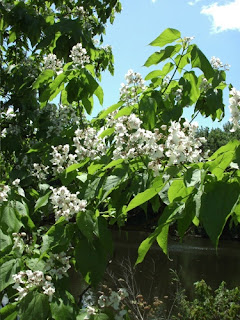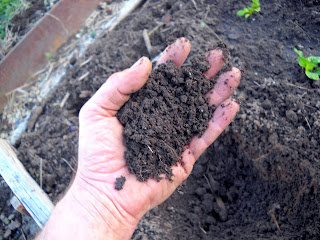 |
| North Hill Viaduct, Akron, Ohio. |
I am from this place: born in Sister Ignatia's St. Thomas Hospital, on the North Hill of Akron, where my people settled after Germany, and made a go of it. I know this place: its hills, its river, the way the canal was forced to elevate itself to its hardscrabble summit, by locks and by channels.
Of course some things change with the decades, but not the soil. Not the clay. Not the bricks.
The little house I grew up in, built the year before my birth (and just in time) was on a piece of an old farm. The red brick farm house, next door, was built of Metropolitan Blocks. They are still fired, by the fifth generation, down in Canton, right here in Ohio, from our substantial red clay.
I like that. A lot.
For some reason, the Mays, who lived next door in the old red house, had a lot of extra old bricks. Each week Mr. May threw away exactly one Metropolitan Block, in each steel trash can, to weigh it down.
 |
| The red brick farm house, and metal trash cans, 1970. |
Eventually, I convinced him to give me the extra bricks, and I lined my first garden with their substantial red clay bulk.
This week I sojourned down to Canton, and saw a beautiful roadway of Metropolitan Block, at Gervasi Vineyard and Winery.
It is fifty five acres of sun-drenched vineyard: artfully composed vistas, a majestic old orchard, a swan filled lagoon, a sun dappled Boccie court, a dining room of rough hewn barn timbers buffed to a loving sheen. But, they had me with the Metropolitan Block.
 |
| Reclaimed barn timbers and re-purposed barn stone, some from the old Massillon State Hospital, now burned. |
A Metropolitan block roadway: a small detail among many such grace notes, on a picture perfect June afternoon, where harp music wafts from the pavilion, down this lane of red fired clay, to an Adirondack chair on the shore of a spring fed lake. In this chair, on this shore: a glass of Vidal Blanc never tasted so sweet. A perfect blend of place, taste, tone.
 | ||
| Willow trees ring the lagoon. |
 | |||
| In every direction, a composed vista. |
 |
| A gracious, hospitable lawn. |
All around, things decades ago we would never predict:
In the valley where a smoky metropolis once dumped its untreated waste, Blue Herons now swoop majestically from tree top rookeries, skimming the water and emerging with beaks full of fish.
On the craggy sandstone banks where the Vaughn Machine company once banged out its wares and then its turbines rusted for decades as its brick walls slowly crumbled, a restaurant and lounge overlook a raging torrent. Walkways to the original Glenns have been restored, and there is talk, increasingly viable, that the big dam is coming down, restoring the Great Falls of which these impressive rapids are just a vestige.
On Saturday mornings, police officers and park rangers have to direct traffic, in the meadow across from the beaver pond just south of Szalay's farm, because the demand is so great for local berries and honey and Swiss chard and peas. Earnest young farmers and wizened old pros preside over stalls of produce grown right here.
It is said we are losing our sense of place, that our kids are addled by too much screen time, can't tolerate peanuts because they have never played in the dirt, don't know that a cherry is a fruit that grows on a tree.
Not quite. There is hope. At the last working farm in the city limits of Canton, owners have burnished and artfully placed bricks of our local clay, the same bricks my neighbor once tossed as ballast for his garbage cans. They have planted new vineyards in an old industrial town.
 |
| New vines on an old farm. |
I like to think, in a few years, we will also be hearing the distant roar of the Great Falls, released from their slumber, behind a superfluous dam built to power electric trolley cars abandoned many, many decades ago.
This place where the river bends: to see this familiar place with fresh eyes, and to imagine what it might sound like one day when its dammed up potential is released, that is the gift of time, and perspective. The patience of one who plants a vineyard. The faith of harvests to come.



















